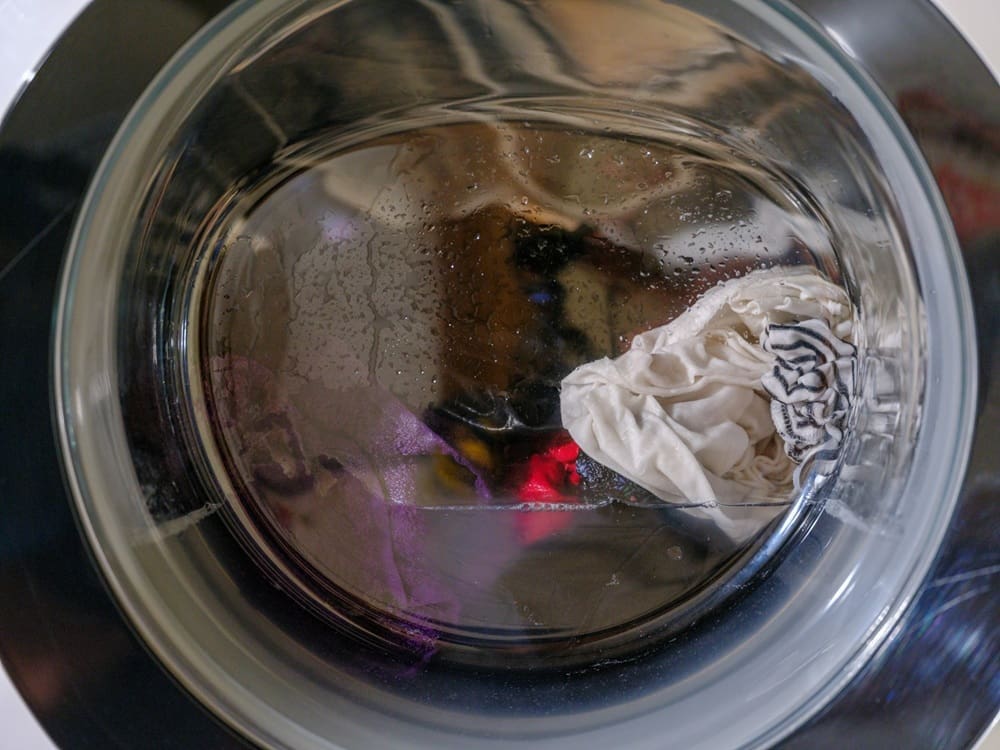Your wedding dress is a delicate masterpiece, and its condition years from now depends heavily on how it’s stored today. Issues like yellowing, fading, and stubborn fabric damage don’t happen by chance. They’re often the result of simple storage oversights that are, in fact, easy to avoid.
The first step is to know exactly what those mistakes look like so you can avoid them from the start. Some are obvious once you hear them, while others are surprisingly common even among well-meaning brides. By spotting them early, you can save your dress from years of preventable damage. Let’s go through the most frequent storage missteps and how to prevent them.
Body oils, sweat, perfume, champagne, and makeup can soak into the fabric without leaving an obvious mark, at least not right away. Over time, those invisible spots oxidize, turning into yellow or brown stains that are extremely difficult to remove. That’s why skipping a professional cleaning before storage is one of the most damaging mistakes a bride can make.
Never store a wedding dress “as is.” Even if you only wore it for a few hours, have it cleaned by a preservation expert first.
Plastic might seem protective, but for wedding dresses, it’s a silent enemy. Over time, many plastics release chemicals that can discolor fabrics, especially delicate fabrics like silk, satin, and lace. Plastic also traps moisture, creating the perfect breeding ground for mildew and odors. While it’s fine for short-term transport, plastic should never be used for long-term storage.
If your dress is still in the bag from the bridal shop, switch it to a breathable cover as soon as you can.
When a wedding dress is stored without acid-free tissue paper, the folds can become sharp creases that damage fibers over time. Standard tissue paper can actually make the problem worse because it contains acids that slowly transfer to the fabric, causing yellowing. Acid-free tissue acts as a safe barrier, keeping folds soft and protecting delicate areas like beadwork and lace.
Invest in preservation-grade acid-free tissue paper. It’s one of the simplest, most affordable ways to prevent yellowing.
Humidity is one of the biggest threats to a stored wedding dress. Basements, attics, and garages often have fluctuating temperatures and moisture levels, which can encourage mildew growth. Once mildew takes hold, it leaves behind musty odors and stains that are nearly impossible to remove without risking fabric damage. Keeping a dress in a climate-controlled space is essential to long-term preservation.
If you wouldn’t store valuable family photos there, don’t store your wedding dress there either.
Veils, gloves, sashes, and other accessories can seem harmless when stored with the dress, but they can cause unexpected damage. Dyes from colored sashes may transfer to the dress, and metal clasps or decorative pins can snag delicate fabrics. Even a lace veil can leave imprints if stored tightly against satin or silk for years. Storing accessories separately keeps them from altering the appearance of the dress over time.
Treat every accessory like it’s just as valuable as the dress, store them with the same level of care.

Your wedding dress deserves more than just a spot in your closet; it deserves expert care that protects every stitch, bead, and memory. At Premier Cleaners, we specialize in bridal dress cleaning and preservation in Westford, Massachusetts, which goes far beyond standard dry cleaning. With advanced techniques and premium, fabric-safe solutions, we help safeguard your dress from yellowing, hidden stains, and long-term fabric damage.
To avoid irreversible discoloration, be sure to bring your dress in within two weeks of your big day, and take advantage of our $25 off for new customers on Wedding Dress Cleaning and Preservation Service orders over $50. Whether your dress is silk, lace, or covered in intricate embellishments, you can trust us to gently care for its every detail.
Have questions? Call us any time at (978) 600-1991, or stop by our location at 9 Cornerstone Square, Suite b700, in Westford. Your dress deserves expert hands and a cleaner you can trust, and at Premier Cleaners, that’s exactly what you’ll get.
Because of the size, the hassle, and the simple fact that comforters don’t look dirty the way sheets or pillowcases do, most of us go way too long between cleanings. But the moment you start to notice that musty smell, the extra weight, or a general dinginess no fluffing can fix, they're clear signs your comforter is overdue for a wash.
So, when is the right time to wash it? Too often, and you risk breaking down the filling. Not often enough, and you end up sleeping under a cloud of dust, dander, and buildup. In this post, we guide you through the ideal cleaning schedule so you’re not overwashing or under-washing. Let’s get into it!
If you have allergies or asthma, your comforter might be making things worse without you even realizing it. Dust mites, pollen, and pet dander build up in bedding over time, especially in thick, warm comforters that don’t get cleaned often.
Even if you wash your sheets weekly, your comforter can still collect irritants that affect your breathing. That’s why it’s important to wash your comforter every 2 to 3 months, minimum.
If you want a healthier night’s sleep with fewer allergic reactions or breathing issues, here are some key things to keep in mind:
Stick to washing your comforter every 2 to 3 months using a large-capacity washing machine with mild, fragrance-free detergent. Always double rinse to remove any leftover soap residue.
If your comforter is machine-washable and made from cotton or polyester, washing it with hot water (at least 130°F) can help kill dust mites. Check the care label first; some textiles, like wool or silk, can't handle heat.
Dry the comforter thoroughly using a low-heat setting and toss in a couple of wool dryer balls or clean tennis balls to maintain loft. Never put a slightly damp comforter back on the bed; it can grow mold or mildew inside the fibers.
Add a removable duvet cover that's easy to wash weekly. This acts as a protective barrier and catches allergens before they reach your comforter.
Sleeping with pets brings comfort, but it also introduces hair, dander, dirt, and sometimes even fleas into your bedding. Comforters are thick and absorbent, so they trap pet debris easily, especially if your pet loves to burrow or sleep right on top of it.
Even if you vacuum or shake it out regularly, that’s not enough to fully clean it. To stay on top of hygiene, wash your comforter every 2 to 3 months.
Before washing, shake the comforter outside to remove loose fur. Use a lint roller or vacuum if needed. Spot clean any pet stains using a solution of vinegar and water or an enzyme-based stain remover.
Use a detergent that’s free from dyes and perfumes to avoid irritating your pet’s skin. Pet-safe laundry soaps also help break down oils and odors more effectively.
Pet hair can cling to fabric even after washing. Run an extra rinse cycle to remove residue and help flush away leftover dander and soap.
Dry thoroughly on low to medium heat with wool dryer balls or clean tennis balls to fluff the fabric and reduce matting. This helps preserve the structure and feel of the comforter.
If you tend to sweat while you sleep, or live in a hot, humid climate, your comforter collects more body oils and moisture than average. Over time, this leads to stains, odors, and even hidden mildew deep inside the filling.
Even if you don’t see visible marks, the sweat soaks into the fabric and weakens it. That’s why you should clean your comforter every season (every 3 to 4 months) to keep it fresh and safe to sleep under.
Pair your comforter with breathable cotton or linen sheets and covers. These materials help wick moisture away from your body and reduce how much sweat seeps into your comforter.
If you notice yellowing or sweat stains around the edges, pretreat them before they set. Use a mixture of water, mild laundry detergent, and a bit of vinegar to lift the stain before a full wash.
When washing, consider adding a half-cup of white vinegar or baking soda along with your detergent to eliminate sweat smells. Avoid using fabric softener; it can coat fibers and lock in odors.
In humid areas, it’s critical to make sure your comforter is fully dry before storing or using it again. Use low heat and allow for a longer drying time. Check for damp spots before folding or remaking the bed.
Accidental spills happen. Whether it’s coffee in the morning or snacks during a movie night, your comforter is bound to pick up stains, crumbs, and sticky residue if you regularly eat in bed. Even if you’re careful, food and drink can soak into the fabric and attract bacteria or bugs.
That’s why you should wash your comforter every 3 months if food or drinks are part of your bedtime routine.
Blot liquid spills immediately with a clean towel to prevent deep soaking. Avoid rubbing, which can spread the stain. Treat the area with diluted dish soap or a laundry stain remover.
Shake the comforter outside every week or two. Use a handheld vacuum or lint roller to collect crumbs stuck in the seams or stitching.
Even if your comforter looks clean, stick to a three-month schedule for full washing. If you spill something greasy or sugary, don’t wait; wash it right away to avoid permanent stains or bad smells.
Use a washable duvet cover that you can strip off and clean after any spills. This reduces how often the inner comforter needs to be washed.
Using a top sheet and a duvet cover offers solid protection for your comforter. These layers catch the bulk of sweat, skin cells, and oils, so your comforter stays cleaner longer. As long as you wash the cover and sheets weekly, your comforter doesn’t need to be cleaned as frequently. Washing every 6 months is usually enough to keep it in good shape.
Always wash your duvet cover and top sheet at least once a week. These layers take the brunt of daily use and keep your comforter shielded from moisture, lint, and body oils.
Every month or so, flip or rotate your comforter to prevent uneven wear. This also helps you spot any early signs of staining or buildup that may require a quicker wash.
Even with a top sheet and cover, check the comforter thoroughly at the start of each season. If it smells musty, has visible stains, or feels flat, wash it even if you’re not at the 6-month mark yet.
On dry days, hang your comforter outside for a few hours. Sunlight helps disinfect, lift odors, and fluff the filling without a full wash.

There’s something about waking up under a freshly cleaned comforter that just makes the day feel better, lighter, calmer, and healthier. If your comforter hasn’t had a deep clean in months (or maybe ever), now’s the perfect time to give it a deep cleaning.
At Premier Cleaners in Westford, Massachusetts, we specialize in dry cleaning comforters, duvets, linens, and more household items. We handle the bulky, delicate items your home washer can’t, using eco-friendly methods and state-of-the-art equipment.
Enjoy both comfort and convenience with Premier Cleaners’ FREE Pickup and Delivery Service. Schedule your comforter cleaning today by calling 978-600-1991. We’re excited to help you start your mornings feeling fresher!
To the unsuspecting person, the last thing they can think of that's causing their clothes to look dull or coated in a strange, filmy residue is the water coming out of their own pipes. But if your freshly washed laundry feels stiff, looks faded, or has that weird chalky texture, there’s a good chance you’re dealing with hard water.
Hard water is loaded with minerals like calcium and magnesium, and while it’s technically safe to use, it’s not doing your clothes (or your detergent) any favors. It messes with how well your soap works, leaves buildup on fabric, and over time, can wear down the softness, brightness, and lifespan of your shirts, dresses, jeans, etc.
If ever you have someone check and confirm you indeed have hard water, keep reading this post. We’re breaking down the simple adjustments you can make to your laundry routine to protect your clothes, boost your detergent’s performance, and finally get that fresh, clean feel you’ve been missing.
Minerals like calcium and magnesium in hard water reduce how well most detergents work, leaving behind soap scum and grime on your clothes. Switching to a detergent formulated for hard water can make a major difference in how your clothing pieces look, feel, and smell after each wash.
Here’s what to look for when choosing the right detergent:
Even the best detergent might not be as effective without a little backup. A laundry booster is designed to neutralize minerals before they interfere with the cleaning process. These additives work alongside your detergent to cut through buildup and improve wash performance.
Here’s how to boost your detergent’s effectiveness:
In hard water conditions, cold water can actually work against you. The minerals in hard water slow down detergent dissolution and make it harder to remove grime, especially when the water is too cool. Warmer temperatures improve cleaning by helping detergent mix properly and breaking up mineral residue.
To make sure your water temperature supports and not sabotages your laundry, try the following:
Hard water makes it especially difficult to get whites clean, and stains can cling to fabric even after a full wash. Pre-soaking gives your detergent more time to break down dirt and mineral buildup before the wash cycle starts. This extra step is especially helpful for whites, uniforms, workout gear, and anything with deep-set grime.
If you’ve never pre-soaked laundry before, here’s how to do it right:

One rinse often isn’t enough when you’re dealing with mineral-heavy water. A second rinse cycle helps wash away leftover detergent, hard water minerals, and soap scum. This is especially important for people with sensitive skin or allergies, since residue buildup can cause irritation.
Hard water doesn’t just leave a mark on your clothing items – it also clogs up your washing machine. Over time, minerals build up on the drum, hoses, and detergent compartments, reducing efficiency and leading to musty odors or breakdowns. Cleaning your washer regularly prevents this and helps maintain optimal performance.
To keep your machine running like it should:
A clean washer keeps your laundry routine smooth and extends the life of your machine – no extra tools required.
When you overload your washer, water and detergent can’t circulate freely, something that’s even more important if you’re dealing with hard water. Clothes come out less clean, and minerals stay trapped in the fabric folds. A packed drum also increases wear and tear on clothing items, especially seams and stitching.
If you don't know how to do your laundry around hard water, or you're just plain tired of doing it at all, Premier Cleaners is here to give you a hand. We're Westford’s Premium Laundry Service provider offering efficient, high-quality wash and fold service to residents and businesses alike in the area. With expert care, eco-friendly products, and standout customer service, try one load with us and you’ll wonder why you ever did it yourself.
Choose your tier: starting at just $39 per bag with FREE pickup and delivery, or join the Premier Laundry Club to save even more. Got questions? Call 978-600-1991, drop us an email at info@premiercleanersma.com, or visit us at 9 Cornerstone Square, b700, Westford, MA 01886.
You hit the gym daily because it clears your mind, builds your confidence, and keeps your body in motion. And while breaking a sweat is great for your body, it’s not always so great for your workout clothes.
Workout clothes are stretchy, breathable fabrics designed to keep you comfortable while you sweat, but they're also made from delicate technical fabrics that don’t hold up well under rough laundry habits. Even the best gym clothes quickly lose their stretch and sweat-wicking power if you wash them like regular laundry.
So starting today, make sure your wash habits match the effort you put into your workouts. Here's exactly how to protect your gym gear from wearing out too soon.
Using the wrong detergent is one of the quickest ways to wear down your workout gear. Most gym clothes are made from fabrics that trap sweat, oils, and odor, and regular detergent simply isn’t built for that.
Here’s how performance detergents stack up against regular detergents, and why switching can make all the difference if you wash gym clothes regularly:
| Feature | Regular Detergent | Performance Detergent |
|---|---|---|
| Designed For | Everyday fabrics (cotton, blends) | Technical fabrics (spandex, nylon, polyester) |
| Odor Removal | May mask smells temporarily with fragrance | Targets bacteria and odor-causing oils directly |
| Residue Buildup | Often leaves behind coating that traps odor | Rinses clean, maintaining fabric breathability |
| Fabric Safety | Can clog moisture-wicking materials | Formulated to preserve stretch, softness, and wicking properties |
| Fragrance and Additives | Scent heavy, sometimes irritating | Usually fragrance free or hypoallergenic |
| Best For | Casualwear, towels, non-athletic items | Workout clothes, undergarments, compression wear, active uniforms |
Fabric Care Tip: Check labels before buying and opt for eco-conscious, environmentally friendly options, if possible. If you use a Wash and Fold Laundry Service, make sure to request a sport-specific or fragrance-free detergent when booking.
Yes, you work out daily—but that doesn’t mean you need to toss every piece you wore into the washing machine every single time. Overwashing breaks down fabrics faster, especially with gear that isn’t soaked in sweat.
Being selective with what you wash doesn’t just cut down your laundry load—it also significantly extends the life of your workout clothes. Constant agitation, heat, and detergent exposure can degrade elastic fibers, fade prints, and weaken seams over time.
If you only have two gym outfits, those pieces are in constant use and constant washing. That’s a fast track to stretched seams, fading prints, and worn-out waistbands.
Rotating your gear gives each item a break and prevents overuse breakdown. You’ll also be less tempted to overdry or rush a wash if you have backups ready.
Heat is the enemy of elasticity. Even one round in the dryer can start to damage your leggings or shrink your performance tops. Most performance fabrics break down when exposed to high heat, which kills stretch, fades color, and warps shape.
Air drying extends the lifespan of your gym clothes, especially anything with spandex or stretch. You’ll be surprised how long your clothes last just by skipping the dryer.

Fabric softener is a laundry additive designed to make clothes feel softer and reduce static cling, but it leaves behind a coating that can interfere with fabric performance. Fabric softener smells great, sure—but it clogs the fibers in performance materials, blocking their moisture-wicking capabilities and locking in odors over time.
Gym clothes don’t play well with jeans, towels, or delicates. They need a separate space both before and during washing to avoid cross-contamination and mechanical damage.
Separating your workout clothes helps reduce friction and odor transfer. This simple step keeps your other laundry clean and your gym gear airing out until it’s time to wash.
If laundry feels like one task too many, a Wash and Fold Laundry Service is a simple way to protect your performance gear and free up your day. Just make sure to note any preferences when dropping off or placing your pickup order.
Armpits, waistbands, and back panels are magnets for odor and residue buildup. If you don’t treat these areas before washing, the smell will linger.
Doing this once a week makes a huge difference in keeping odors at bay and gear in good shape.
Even clean clothes can get damaged if stored in the wrong conditions. Moisture, dust, and poor airflow can lead to mildew, musty smells, or stretched fabric.
If you store clothes near your bed, closet, or apartment entryway, keep things elevated, clean, and dry.
You have nothing to worry about when your activewear is in our hands. At Premier Cleaners, we know how hard you train—and we’re here to make sure your clothes can keep up. As part of our Premium Laundry Club in Westford, Massachusetts, our Wash and Fold Laundry Service is designed to give busy, fitness-focused people like you the convenience you need without compromising on care. One load with us, and you’ll wonder why you ever did it yourself.
We use high-quality, skin-safe products that are tough on odors but gentle on technical fabrics like spandex, mesh, and performance blends. Our experienced team knows how to treat each piece right—separating, washing, and folding with precision.
Drop off your laundry or let us come to you—our FREE Pickup and Delivery Service means we handle it all, right from your doorstep. Work out hard. Live more. Let Premier Cleaners take care of the laundry.
Visit us: 9 Cornerstone Square b700, Westford, MA, 01886
📞 Call us: +1 978 600 1991
📧 Email: info@premiercleanersma.com
Book your service today!

